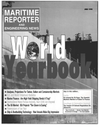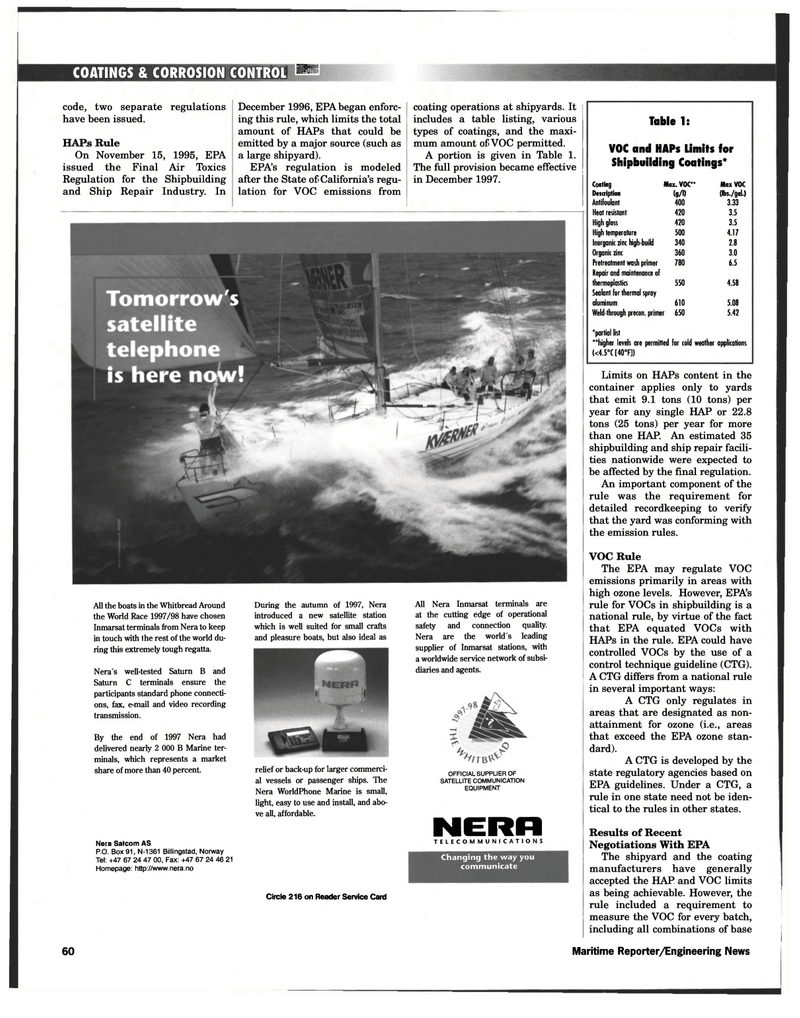
Page 81: of Maritime Reporter Magazine (June 1998)
Read this page in Pdf, Flash or Html5 edition of June 1998 Maritime Reporter Magazine
COATINGS & CORROSION CONTROL
Changing the way you communicate
HI 'partial list "higher levels are permitted for cold weather applications (<4.5°C [40°F])
Limits on HAPs content in the container applies only to yards that emit 9.1 tons (10 tons) per year for any single HAP or 22.8 tons (25 tons) per year for more than one HAP. An estimated 35 shipbuilding and ship repair facili- ties nationwide were expected to be affected by the final regulation.
An important component of the rule was the requirement for detailed recordkeeping to verify that the yard was conforming with the emission rules.
Table 1:
VOC and HAPs Limits for
Shipbuilding Coatings*
Coating Max. VOC" Max VOC
Description (g/1) (Ibs./gal.)
Antifoulant 400 3.33
Heat resistant 420 3.5
High gloss 420 3.5
High temperature 500 4.17
Inorganic zinc high-build 340 2.8
Organic zinc 360 3.0
Pretreatment wash primer 780 6.5
Repair and maintenance of thermoplastics 550 4.58
Sealant for thermal spray aluminum 610 5.08
Weld-through precon. primer 650 5.42 code, two separate regulations have been issued.
HAPs Rule
On November 15, 1995, EPA issued the Final Air Toxics
Regulation for the Shipbuilding and Ship Repair Industry. In
December 1996, EPA began enforc- ing this rule, which limits the total amount of HAPs that could be emitted by a major source (such as a large shipyard).
EPA's regulation is modeled after the State of California's regu- lation for VOC emissions from coating operations at shipyards. It includes a table listing, various types of coatings, and the maxi- mum amount of VOC permitted.
A portion is given in Table 1.
The full provision became effective in December 1997.
VOC Rule
The EPA may regulate VOC emissions primarily in areas with high ozone levels. However, EPA's rule for VOCs in shipbuilding is a national rule, by virtue of the fact that EPA equated VOCs with
HAPs in the rule. EPA could have controlled VOCs by the use of a control technique guideline (CTG).
A CTG differs from a national rule in several important ways:
A CTG only regulates in areas that are designated as non- attainment for ozone (i.e., areas that exceed the EPA ozone stan- dard).
A CTG is developed by the state regulatory agencies based on
EPA guidelines. Under a CTG, a rule in one state need not be iden- tical to the rules in other states.
Results of Recent
Negotiations With EPA
The shipyard and the coating manufacturers have generally accepted the HAP and VOC limits as being achievable. However, the rule included a requirement to measure the VOC for every batch, including all combinations of base
Nera Satcom AS
P.O. Box 91, N-1361 Billingstad, Norway
Tel: +47 67 24 47 00, Fax: +47 67 24 46 21
Homepage: http://www.nera.no
Circle 216 on Reader Service Card
All Nera Inmarsat terminals are at the cutting edge of operational safety and connection quality.
Nera are the world's leading supplier of Inmarsat stations, with a worldwide service network of subsi- diaries and agents.
NERH
TELECOMMUNICATIONS
All the boats in the Whitbread Around the World Race 1997/98 have chosen
Inmarsat terminals from Nera to keep in touch with the rest of the world du- ring this extremely tough regatta.
Nera's well-tested Saturn B and
Saturn C terminals ensure the participants standard phone connecti- ons, fax, e-mail and video recording transmission.
By the end of 1997 Nera had delivered nearly 2 000 B Marine ter- minals, which represents a market share of more than 40 percent. OFFICIAL SUPPLIER OF
SATELLITE COMMUNICATION
EQUIPMENT
During the autumn of 1997, Nera introduced a new satellite station which is well suited for small crafts and pleasure boats, but also ideal as relief or back-up for larger commerci- al vessels or passenger ships. The
Nera WorldPhone Marine is small, light, easy to use and install, and abo- ve all, affordable. 60 Maritime Reporter/Engineering News

 80
80

 82
82
